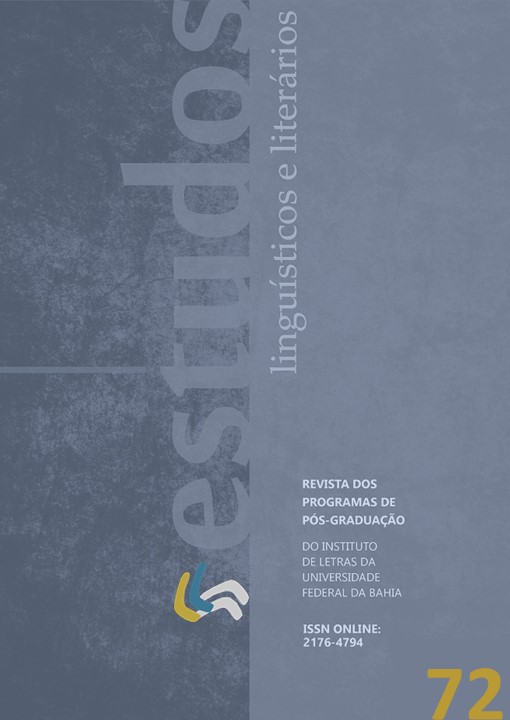NON-MANUAL FEATURES OF EVENTUALITIES IN LIBRAS
DOI:
https://doi.org/10.9771/ell.i72.46602Keywords:
Features, Eventualities, LibrasAbstract
The objective of this paper is to describe non-manual features as eventuality properties in Brazilian Sign Language – Libras. Based on the notions of aspect and actional classes (VENDLER, 1957; COMRIE, 1976; SMITH, 1991), it is acknowledged that the co-occurrence of activities in the lower face (mouth, cheeks, and chin) with manual articulation expresses the nature of the time schemata of the predicate. The theoretical framework used is Distributed Morphology (HALLE; MARANTZ, 1993), upon the premise that eventualities and subevents comprising them must be codified in syntax. Instantaneous/durative and telic/atelic features were investigated based on samples from the natural signing of three deaf adult informants. The results obtained are: a) the [+ continuous] feature characterizes durative eventualities; b) the [+ punctual] feature characterizes telic eventualities. It is expected that this research will contribute to the description of phonological features compatible with the visual-spatial modality.
Downloads
References
AARONS, D. Aspects of the syntax of American Sign Language. 200f. Tese (Doutorado em Filosofia) - Boston University, Boston, 1994.
BAHAN, B. J. Non-manual realization of agreement in American Sign Language. 342f. Tese (Doutorado em Filosofia) - Boston University, Boston, 1996.
BAKER-SHENK, C. A micro analysis of the nonmanual components of American Sign Language. Unpublished PhD thesis, University of California, Berkeley, USA, 1983.
BELLUGI, U.; KLIMA, E. S. The signs of language. Psychological Science, [S.l.], v. 1, p. 6-9, 1979.
BICKFORD, J. A.; FRAYCHINEAUD, K. Mouth morphemes in ASL: A closer look. In: QUADROS, R. M. (ed.). Sign Languages: spinning and unraveling the past, present and future (papers from the Ninth Theoretical Issues in Sign Language Research Conference, Florianopolis, Brazil, December 2006). Petrolis, RJ: Editora Arara Azul, 2008.
BRITO, L. F. Língua brasileira de sinais – LIBRAS. In: BRITO, L. F. et al. (org.). Brasília: Secretaria de Educação Especial, v. 3, 1998.
BRITO, L. F. Por uma gramática de línguas de sinais. 2. ed. Rio de Janeiro: Tempo Brasileiro, 2010.
COMRIE, B. Aspect: an introduction to the study of verbal aspect and related problems. Cambridge: Cambridge University Press,1976.
CRASBORN, O. et al. Frequency distribution and spreading behavior of diferente types of mouth actions in three sign languages. Sign Language & Linguistics, v. 11, n. 1, p. 4567, 2008.
EMBICK, D; MARANTZ, A. Architecture and blocking. Linguistic inquiry, v. 39, n. 1, p. 1-53, 2008.
FELIPE, T. A relação sintático-semântica dos verbos na Língua Brasileira de Sinais. Rio de Janeiro: UFRJ, Tese de doutorado em linguística, 1998
FIGUEIREDO, L. M. B.; LOURENÇO, G. Analisando a Língua Brasileira de Sinais como uma língua sem-tense. Scripta, Belo Horizonte, v. 24, n. 51, p. 361-396, 2020.
FINAU, R. Os Sinais do Tempo e Aspecto na Libras. Tese de doutorado. Setor de Ciências Humanas, Letras e Artes, Universidade Federal do Paraná, Curitiba, 2004.
HALLE, M.; MARANTZ, A. Distributed morphology and the pieces of inflection. In: HALE, Kenneth; KEYSER, S. Jay (ed.). The view from building 20. Cambridge: MIT Press, 1993.
LEWIN, D.; SCHEMBRI, A. Adverbial mouth gestures in British Sign Language: A case study of tongue protrusion in BSL narratives. In: Workshop on nonmanuals in sign languages, 4-5 apr., Frankfurt, 2009.
LIDDELL, S. K.; JOHNSON, R. E. American Sign Language compound formation processes, lexicalization, and phonological remnants. Natural Language & Linguistic Theory, [S.l.], v. 4, n. 4, p. 445-513, 1986.
OLIVEIRA, F. A. Distinção entre aspecto lexical e aspecto gramatical na Língua Brasileira de Sinais. Dissertação (mestrado). Universidade Federal do Paraná, Setor de Ciências Humanas, Programa de Pós-Graduação em Letras, 2018.
PIRES, G. S. A. Aspectualidade em libras: telicidade e duratividade. Dissertação (Mestrado). Programa de Pós-Graduação em Estudos da Linguagem. Universidade Federal Fluminense, 2019.
QUADROS, R. M. KARNOPP, L. Língua de sinais brasileira: estudos linguísticos. Porto Alegre: Artmed, 2004.
SANDLER, W. Symbiotic symbolization by hand and mouth in sign language. Semiotica, [S.l.], v. 2009, n. 174, 2009.
SANTOS, H. R. Processos de expansão lexical da Libras no ambiente acadêmico. Dissertação (Mestrado em Linguística e Língua Portuguesa). Programa de Pós-Graduação em Letras. Pontifícia Universidade Católica de Minas Gerais, 2017.
SANTOS, H. R. Traços categorizadores na derivação de pares nome-verbo em Libras. Scripta, 24(51), p. 488-513, 2020.
SANTOS, H. R. Propriedades aspectuais de eventualidades em Libras: um compartilhamento de traços fonológicos entre articuladores manuais e não manuais. Tese (Mestrado em Linguística e Língua Portuguesa). Programa de Pós-Graduação em Letras. Pontifícia Universidade Católica de Minas Gerais, 2021.
SCHER, Ana Paula. As construções com o verbo leve "dar" e nominalizações em -ada no português do Brasil. Tese (doutorado) - Universidade Estadual de Campinas, Instituto de Estudos da Linguagem, Campinas, 2004.
SILVA, L. Investigando a Categoria Aspectual na Aquisição da Língua Brasileira de Sinais. Dissertação. (Mestrado em Linguística) – Centro de Comunicação e Expressão, Universidade Federal de Santa Catarina, Florianópolis, 2010.
SMITH, C. The Parameter of Aspect. Dordrecht: Kluver, 1991.
VENDLER, Z. Causal relations. The Journal of philosophy, [S.l.], v. 64, n. 21, p. 704-713, 1967.
VERKUYL, H. J. A Theory of Aspectuality. Cambridge: Cambrige University Press, 1993.
VERKUYL, H. J. Aspectual Issues: Studies on Time and Quantity. Stanford: CSLI Publications, 1999.
WILBUR, R. B. Complex predicates involving events, time, and aspect: Is this why sign languages look so similar? In: QUER, J. (Ed.). Signs of the time: Selected papers from TISLR 2004. Hamburg: Signum-‐Verlag, 2008. p. 217–‐250.
WILBUR, R. B. Modality and the structure of language: Sign languages versus signed systems. In: MARSCHARK, MARC; SPENCER, PATRICIA E (Org.). Oxford Handbook of Deaf Studies, Language, and Education. New York: Oxford University Press, 2003. p. 332-346.
WOLL, B. The sign that dares to speak its name: Echo phonology in British Sign Language (BSL). In: BOYESBRAEM, P.; SUTTON-SPENCE, R. L. The hands are the head of the mouth. Hamburgo: Signum Press, 2001.
XAVIER, A. N. Análise preliminar de expressões não-manuais lexicais na libras. Revista Intercâmbio, v. XL:41-66, 2019.


